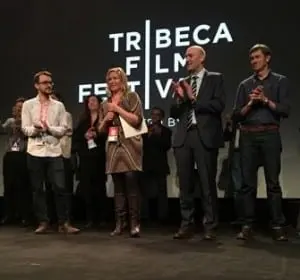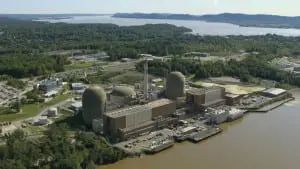Two key issues, two different presentations
By Kevin E. Foley
Earth Day is meant to signify a heightened awareness of the environment we humans live in, locally as well as the planet we as a species occupy in anxious harmony with millions of other species. This year is the 45th time the day (April 22) has been marked by public events now as much by elected officials (the president in the Everglades) and corporations (buy today and we’ll plant a tree) as environmental activists. In 2015 perhaps it can be observed that public awareness is greatly heightened as to the challenges our natural world confronts.
In the last week, two local residents, Nicholas Groombridge and Ivy Meeropol, offered perspectives on a pair of critical issues — world population and nuclear power — that bear witness to the necessity of having an Earth-Day-is-every-day awareness.
A film
After several years of seeking access, interviewing numerous people involved and filming in various interesting places, Meeropol premiered her documentary film Indian Point at the Tribeca Film Festival in New York City last week (April 17). If you have ever wanted to better understand the stakes involved with nuclear energy as a power source and/or specifically the issues surrounding the Indian Point plant on the Hudson River, which is presently up for federal relicensing, or if you have simply wondered what actually goes on inside the nuclear power plant 10 miles south of Philipstown, then this film is for you.

In the course of the work, Meeropol displays several virtues (among them curiosity, patience, balance, empathy) needed to explore and present a complicated issue that so often we choose or need to ignore to get on with our lives.
Questions abound through the film. Some are answered, some show the need for further examination, some are for the viewer:
- Are you prepared for the evacuation plan should a real alert be issued?
- Do you know how many Hudson River fish are killed annually in the process of cooling the power plant?
- Is New York City really dependent on power from Indian Point as is so often stated?
- Does the federal Nuclear Regulatory Commission (NRC) invoke the highest safety standards when considering the operation of nuclear power plants?
Most striking about the documentary is the filmmaker’s determination to present as much of all aspects of the role the Indian Point plant plays in the life of the Hudson Valley and New York City as she can reasonably fit into a couple of hours. That includes time spent up close and personal with the people who enter the power plant every day and maintain its round-the-clock operation.
Entergy, the energy company that owns Indian Point, took a chance on getting a fair hearing in granting Meeropol wide access to the plant and the people running it. Physically the plant is seen as both an efficient, clean, well-lit place and an aging structure in need of repair and upgrade. She puts a very human face (literally warts and all) on these people, the same as she does on those who work to warn us the plant needs to be shut down or at least be subjected to a higher degree of scrutiny and safety standards.

Meeropol’s camera, which often seems restless and hungry to learn more, also accompanies the former chairman of the NRC to Japan (where he is apparently more appreciated than in the U.S.) to review the aftermath of the Fukushima nuclear disaster, which saw terrible death and destruction from an earthquake, tsunami and radioactive core meltdown. There are lasting and not yet fully understood aftereffects from the release of radiation in the atmosphere, land and ocean. Radioactive water was released from the site just the other day, according to news reports.
A talk
“Population is the biggest environmental issue,” said Groombridge in a talk he gave at the Garrison Institute for its annual Earth Day dinner held on Thursday, April 16. The dinner, as it does every year, featured foods from the kitchen of Shelly Boris’ Fresh Company with recipes from countries related to the talk. This year appetizers came from Asia (Japan, China, Indonesia), while dinner offerings featured Brazil, Mexico and Egypt, where the population challenges are most acute.

Groombridge, a New York City–based law firm partner (Paul, Weiss) specializing in patent law (and a Philipstown.Info, Inc. board member), has a long involvement with an organization that raises funds and awareness in support of the United Nations Population Fund, whose mission states: “Delivering a world where every pregnancy is wanted, every childbirth is safe and every young person’s potential is fulfilled.”
Working through some of Groombridge’s many salient points about population, we learn that there are nearly 7 billion people inhabiting the earth now with the possibility of 12 billion by 2100 — the life span of a child born today. (He warns predictions can go awry.) The current age of booming population is very new in human history (if you are over 45, the world population has doubled in your lifetime). For a long time human life was a doubtful prospect — 70 or 80,000 years ago there were fewer humans walking the earth than in Philipstown today.
The storage and distribution of potable water, development of consistent and better nutrition and an understanding of infectious diseases all contributed to people living longer lives and therefore to the rapid growth in population in the last couple of centuries.
One giant consideration for the societies of the earth is the sustainability of population growth along with the understanding that the growth is very uneven in its distribution geographically. Groombridge said, “Economic development is the key to a country’s carrying capacity” for its population. He pointed to enhanced food production as a proud accomplishment of humankind. He indicated current production actually exceeds human needs but then warned that the curve is bending away from excess to a leveling out and potential decline against population growth.
Groombridge warned that a continuing loss of biodiversity and climate change also threaten sustainability generally. Water availability is also crucial to sustaining population, but he cited China and California as exceptions to a generally good water situation worldwide.
“The easiest way to improve the lot of human society is to first, educate girls, and second, allow women to control their pregnancies,” said Groombridge. “We may take these things for granted but not in other places.”
Population decline
While many countries in Africa and Asia will have to wrestle with future growth, some countries, notably Russia, Japan and most of Europe, suffer from the reverse — rapid population decline. Groombridge said Japan’s birthrate was 1.2 children per household with a population replacement rate pegged at 2.1. Japan and the other countries face severe challenges supporting an aging population with fewer and fewer working-age people.
He said history has shown that governments have not succeeded in trying to persuade citizens to have more children when they were not otherwise inclined to do so. Instead he pointed to immigration as the solution to population decline. “Immigration should be seen as a sign of success, not failure,” he concluded.


Unfortunately I was unable to attend either event.
These are two extremely important topics and while I may in some ways disagree with the analysis or the judgment as reported, and also by the formats of the events, I applaud this paper’s coverage and I certainly encourage a continuing attention by its influential readership.
I can say that in my view nuclear technology in general – not limited to the so-called peaceful uses such as electric power generation – has been on balance from day one a monumental disaster for humankind as well as for the environment.
“…not yet fully understood aftereffects from the release of radiation in the atmosphere, land and ocean…”
The more we understand them, the more clear it becomes how minor they are. Read UNSCEAR’s report indicating the (lack of) health impacts from Fukushima radiation.